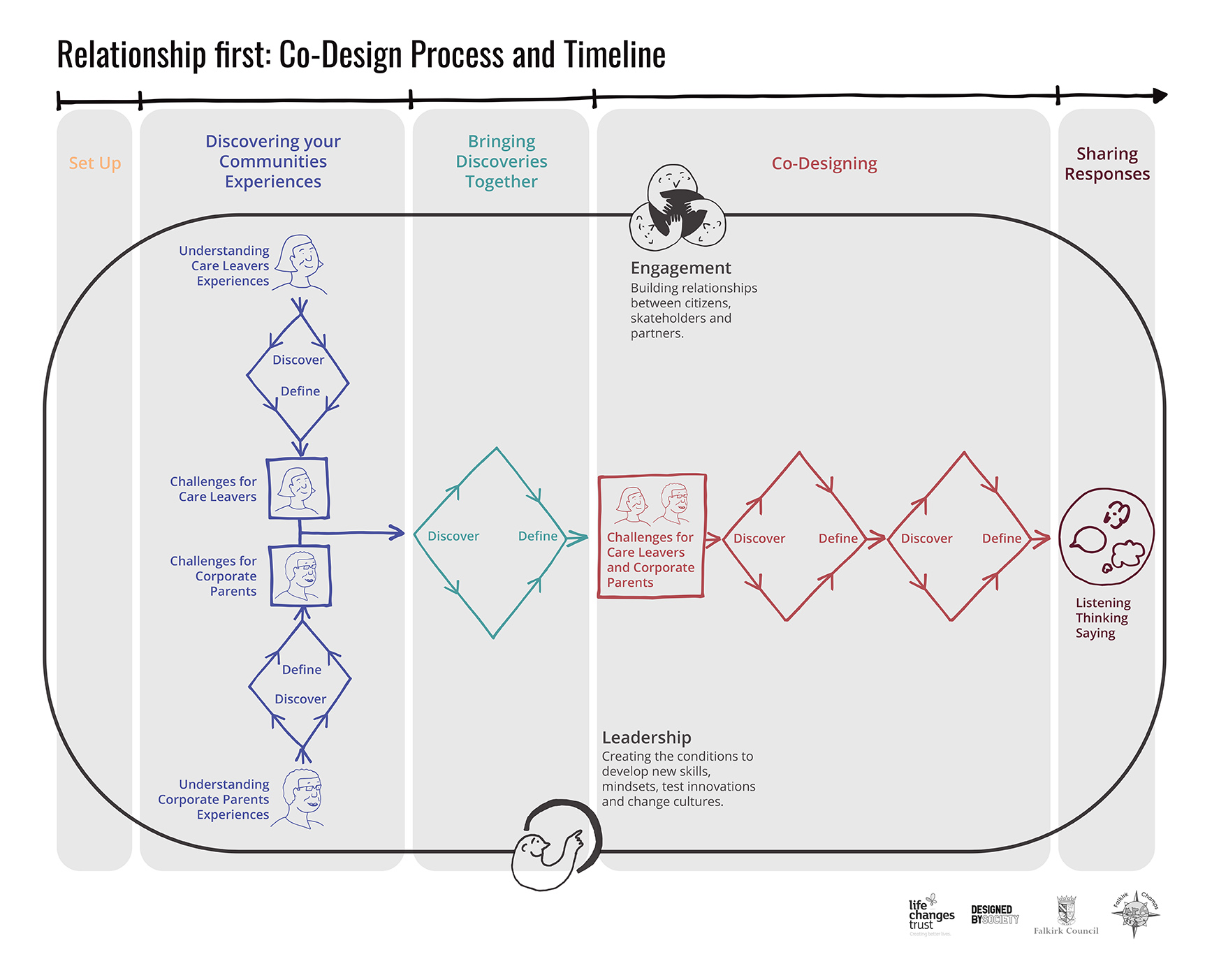What we're doing
We’re on learning journey, challenging ourselves and current systems to better enable relationships between care leavers and people who care for them.
We’re working through a participatory design process, applying systems leadership principles and service design practices to co-design responses to the issues we identify.

Our Vision
To care for our Care Leavers like we would our own children
Our Mission
To put love and relationships at the heart of leaving care service provision
Our Challenge
To translate our vision and mission into sustainable policies and practices
1. Project set up
The purpose of this stage is to:
- Develop a collaborative strategic team (Coordination Crew).
- Enable the Coordination Crew to learn about systems leadership, service design and facilitation practices.
- Review evidence about relationship-based practice and the Falkirk Council’s Corporate Parenting strategies.
- Connect with people in Falkirk Council, including the Senior Corporate Management Team.
- Conduct research with the Leaving Care Team about their views of relationship-based practice in Falkirk Council.
- Recruit people with care experience to create a Citizen Team, and a range of Corporate Parents from Falkirk Council to create a Public Servant Team.
- Enable team building and group working experiences for each Team.
- Train Citizen and Public Servant Teams in systems leadership principles and service design practices.
2. Discovering Your Communities Experiences’
The purpose of this stage is for the Citizen and Public Servant Teams to learn about their communities experiences’ of engaging in relationships and supporting young people as they leave care.
- Seven people with care experience shared their experiences of relationships that were important to them when in and leaving care.
- Thirty corporate parents – from a range of Falkirk Council services – were interviewed to learn about their knowledge and experiences’ of being corporate parents.
Each Team also took time to think about what the project vision and mission would look like in practice. They described what corporate parents would say, think and do when loving care leavers like their own children and how care leavers may feel in response.
The insights and findings from this work enabled each team to develop presentations to share what they found.
3. Bringing Discoveries Together
This stage involved the Citizen and Public Servant Teams sharing their insights and findings with one another. They became the Co-Design Crew, and together identifed the issues they wanted this project to focus on.
They did this by sharing their interpretation of the project vision and mission and creating a collaborative description, sharing their research findings, acknowledging new interpretations, and exploring similarites and differences, and collaborativley identifying the barriers to the vision they wanted to focus on.
4. Co-Designing
We had planned to use experience labs to co-design more ways of supporting the workforce to engage in relationship-based practices at work. This method enables people to collaboratively design for an experience, test it out and work the feedback into the service design development. This method also invites people into a learning space. Experiencing the service design – instead of being told about it – means more senses and emotions can be stimulated when reflecting on an experience of this service and a practical jumping off point from which to think about their actions, needs and role. Facilitated conversations in this learning space can also lead to new connections, alliances, support systems, ideas, networks and a community of collaborative practice; one keen to see support the embedding of their service experience as part of practice.
Due to physical distancing restrictions we were unable to work with this method and we moved to work online developing service design concepts we’d share through storytelling and policy prototyping techniques. To do this we moved into three groups and each group worked with a service designer.
Each group focused on one of the top three themes identifed when the experience research findings were combined. These themse were:
1) Behaviour: better supporting the ways people relate to one another (with a focus on being trauma informed)
2) Systems Change: the system Falkirk Council is part of becoming more human
3) Barriers: addressing the range of everyday barriers people experience
As each teams work developed these themes became appreciative and were described as:
1) Nurturing the workforce
2) Being your self at work
3) Humanising the System
Once the service design concets had been finalised they were named as:
1) Hug in a Mug
2) Heart on Sleeve
3) Share the Care
Learn about the process each group worked through to co-design each service design concept and policy prototype, or…. jump straight to the service design presentations for Hug in a Mug, Heart on Sleeve and Share the Care.
5. Sharing Responses
We are now at the stage of sharing the three service design concepts through online presentations with the Champions Participation Group, Children’s Commission Leadership Group and Falkirk Council Corporate Management Team. Blog posts to come about their feedback and next steps!